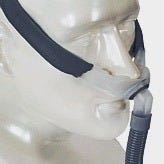
Join Our Email List!
Be the first to know about our latest special offers, promotions, company updates, and more!

The smallest, lightest, and least intrusive of all mask styles, CPAP nasal pillows have silicone or gel cushions that create a seal against each of your nostrils. Like nasal masks, CPAP masks with nasal pillows are a good fit for active sleepers, side sleepers, stomach sleepers, and those with facial hair. Since the seal is created around your nostrils rather than the entire base of your nose or around your nose and mouth like other masks, it can be easier to find a comfortable fit with a CPAP pillow mask. Many masks come with several cushion sizes so you can swap them out to find the best option. Shop affordable CPAP nose pillow masks at CPAP Supply USA, each with free shipping included.